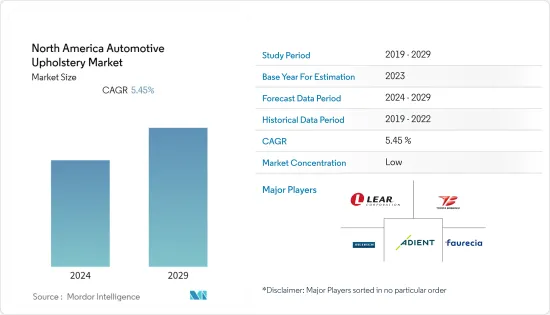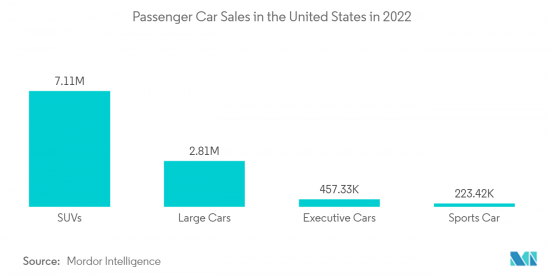PUBLISHER: Mordor Intelligence | PRODUCT CODE: 1406238

PUBLISHER: Mordor Intelligence | PRODUCT CODE: 1406238
North America Automotive Upholstery - Market Share Analysis, Industry Trends & Statistics, Growth Forecasts 2024 - 2029

The North American Automotive Upholstery Market was valued at USD 1.7 billion, and it is expected to reach USD 2.22 billion over the period of the next five years by registering a CAGR of 5.45% during the forecast period.
Over the long term, demand for innovative automotive technology and vehicle interiors is likely to drive demand in automotive upholstery throughout the forecast period, with a growing emphasis on lightweight automotive materials and the development of various non-fabric replacements.
Furthermore, the increased demand for customized interiors in vehicles has contributed. The demand for more personalized vehicles is growing around the world. Car customization plays a significant role in making the car more personalized, owing to which the need for top-class upholstery is growing. Another factor that is driving the Automotive Upholstery demand is the rise in autonomous driving and luxury car sales. Furthermore, numerous automotive manufacturers are concentrating on manufacturing better products in order to provide better products to their clients.
For those interested in adding a luxury element to their cars, leather has remained in demand amongst the wealthy. Moreover, it is known for giving a premium look and feel. As a result, leather upholstery offers certain utilitarian benefits over ordinary materials used in car interiors. This is forcing automakers and OEMs to provide leather upholstery in their mid-range and premium car offerings, thereby driving the development of the leather segment of the automotive industry.
On the other hand, shifting raw material prices and rigorous government laws and regulations for lowering HAP (hazardous air pollutants) emissions are expected to limit market growth. Nonetheless, the emergence of self-driving cars creates new potential for North American automotive upholstery producers during the projection period.
However, the rising cost of raw materials and early wear and tear leads to cut-throat competition amongst the upholstery manufacturers. Nevertheless, engineers are developing innovative and affordable materials that can both satisfy the aesthetic and the damages to the upholstery as a result of smoking, liquid spillage, and collisions.
North America Automotive Upholstery Market Trends
Increasing Demand for Aftermarket Upholstery Modifications May Drive the Market
Aftermarket upholstery modification allows to personalize and customize the interior of vehicles according to preferences. Aftermarket upholstery offers a wide range of materials, colors, and patterns not typically available in OEM options. It also allows for repairs or upgrades to worn-out or damaged seats, enhancing comfort and aesthetics.
Furthermore, customers may choose aftermarket upholstery to improve durability, add special features like heating or cooling elements, or incorporate unique designs that reflect their personality. Overall, aftermarket upholstery modifications provide a way to enhance the interior of vehicles and create a more pleasing experience. Quality, aesthetics, comfort, customization options, and ease of maintenance are the key attributes that are the focus of customers when considering aftermarket upholstery modifications.
High-quality materials and craftsmanship, visually appealing designs, comfortable seating experiences, customization choices, easy maintenance, and a balance between cost and overall value are the factors that are likely to fuel the demand for aftermarket upholstery modifications. The most preferred material for aftermarket upholstery modifications varies depending on individual preferences. However, leather is often favored for its luxurious appearance, durability, and value. It exudes a high-end feel and is associated with luxury vehicles. Additionally, leather is known for its ease of cleaning and maintenance.
Fabric is often chosen for its comfort, affordability, and versatility. Ultimately, the choice of material in aftermarket upholstery modifications is a subjective decision based on factors such as personal style, budget, and desired level of sophistication.
The demand for aftermarket upholstery modifications is expected to persist in the coming decade due to the ongoing desire for vehicle customization, advancements in materials and technology, and the ability to enhance the longevity and value of vehicles through personalized interior upgrades.

United States Holds the Largest Market Share
The vehicle's interior may not be a deal-breaker or winning feature for the customer.; however, they are the customer's first and last contact with the car. The primary function for passengers while purchasing Automotive Upholstery for a car, truck, or SUV, after the cost and quality of the material, is the contrasting surfaces and textures used to bring in a decorative effect and functionality. As a result, automotive makers are considering new materials for upholstery with enhanced environmental performance.
For those interested in adding a luxury element to their cars, leather has remained in demand amongst the wealthy. Moreover, it is known for giving a premium look and feel. As a result, leather upholstery offers certain utilitarian benefits over ordinary materials used in car interiors. This is forcing automakers and OEMs to provide leather upholstery in their mid-range and premium car offerings, thereby driving the development of the leather segment of the automotive industry.
Every year, the American automobile sector requires more than 229,300 tons of automotive textiles, including 9,700 tons of headliners (ceilings), 38,500 tons of carpets, 50,070 tons of woven tire cord, and 20,000 tons of seatbelt fabric. The international market for American-made automobile upholstery and textiles is expanding.
There is also a growing demand for luxury cars. Consumers today are willing to shell out extra cash for luxurious upholstery in vehicles. In the United States, luxury variants of pickup vans and MUVs are offered with leather upholstery as an optional fit. With the trend of owning luxurious vehicles in the United States, opportunities for automotive upholstery are also on the rise. In 2022, Tesla was the leading luxury car brand in the United States, recording sales of nearly 484,400 units. It edged out its main competitor, BMW, which recorded estimated sales of over 327,900 vehicles; this shall be reflected in the Automotive Upholstery Market as well.
North America Automotive Upholstery Industry Overview
The North American Automotive Upholstery market is fragmented with various small and medium-sized companies such as Adient PLC, Grupo Antolin, Panasonic Corp., Faurecia, and Lear Corporation. The major car manufacturers are setting up their upholstery manufacturing factories. However, in order to have an edge over its competitors, the major car manufacturers are making joint ventures and partnerships to launch newer products. For instance,
In May 2023, Toyota is redesigning seat frames for the future of pleasant automobile interiors, boosting safety, comfort, and sustainability. Using generative design produces forms that human designers would not have created while adhering to design requirements such as size and weight.
In October 2022, Lear Inc. of Southfield, Michigan, revealed a 100% recyclable suede material that it expects to debut in seating and door panel applications with a major carmaker in 2024.
Hence, owing to the factors above, the automotive Upholstery market in North America is expected to grow during the forecast period.
Additional Benefits:
- The market estimate (ME) sheet in Excel format
- 3 months of analyst support
TABLE OF CONTENTS
1 INTRODUCTION
- 1.1 Study Assumptions
- 1.2 Scope of the Study
2 RESEARCH METHODOLOGY
3 EXECUTIVE SUMMARY
4 MARKET DYNAMICS
- 4.1 Market Drivers
- 4.1.1 Increase in Passenger Car Sales Propelling Market Growth
- 4.2 Market Restraints
- 4.2.1 Fluctuation in Raw Material Prices
- 4.3 Porter's Five Forces Analysis
- 4.3.1 Bargaining Power of Suppliers
- 4.3.2 Bargaining Power of Buyers/Consumers
- 4.3.3 Threat of New Entrants
- 4.3.4 Threat of Substitute Products
- 4.3.5 Intensity of Competitive Rivalry
5 MARKET SEGMENTATION (Market Size in USD)
- 5.1 Material Type
- 5.1.1 Leather
- 5.1.2 Vinyl
- 5.1.3 Other Material Types
- 5.2 Sales Channel
- 5.2.1 OEM
- 5.2.2 Aftermarket
- 5.3 Product
- 5.3.1 Dashboard
- 5.3.2 Seats
- 5.3.3 Roof Liners
- 5.3.4 Door Trim
6 Geography
- 6.1 North America
- 6.1.1 United States
- 6.1.2 Canada
- 6.1.3 Rest Of North America
7 COMPETITIVE LANDSCAPE
- 7.1 Vendor Market Share
- 7.2 Company Profiles
- 7.2.1 Lear Corp
- 7.2.2 Toyota Boshoku Corp.
- 7.2.3 Seiren Co. Ltd.
- 7.2.4 Adient Plc
- 7.2.5 Faurecia SE
- 7.2.6 CMI Enterprise
- 7.2.7 IMS Nonwoven
- 7.2.8 The Woodbridge Group
- 7.2.9 Katzkin Leather Inc.
8 MARKET OPPORTUNITIES AND FUTURE TRENDS




